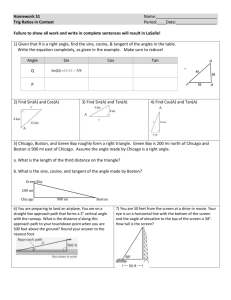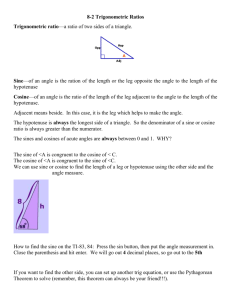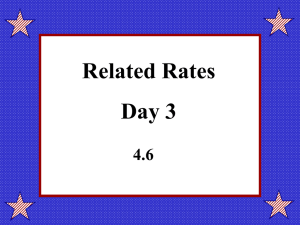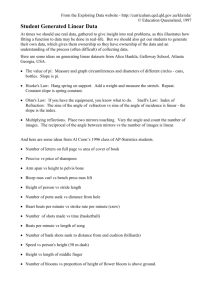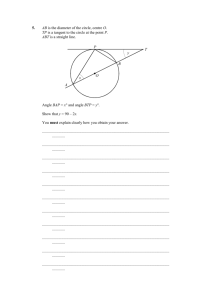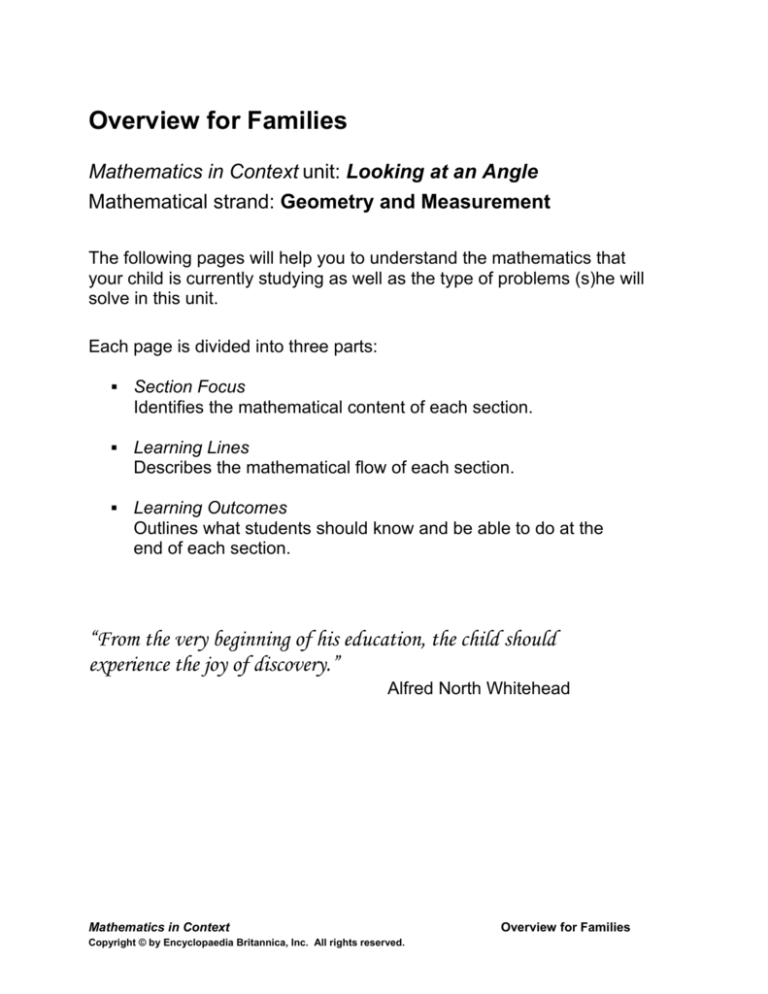
Overview for Families
Mathematics in Context unit: Looking at an Angle
Mathematical strand: Geometry and Measurement
The following pages will help you to understand the mathematics that
your child is currently studying as well as the type of problems (s)he will
solve in this unit.
Each page is divided into three parts:
▪ Section Focus
Identifies the mathematical content of each section.
▪ Learning Lines
Describes the mathematical flow of each section.
▪ Learning Outcomes
Outlines what students should know and be able to do at the
end of each section.
“From the very beginning of his education, the child should
experience the joy of discovery.”
Alfred North Whitehead
Mathematics in Context
Copyright © by Encyclopaedia Britannica, Inc. All rights reserved.
Overview for Families
Looking at an Angle
Section A
Now You See It, Now You Don’t
Section Focus
The instructional focus of Section A is to
• discover the concept of vision line;
• investigate situations involving vision lines and blind spots;
• construct vision lines in two- and three-dimensional representations;
• measure angles; and
• use ratio to solve problems involving vision lines and blind spots.
Learning Lines
Informal Exploration of Steepness and Angle of Elevation
This section focuses on different contexts in which vision plays a role:
• a hiker on the rim of the Grand Canyon looking down trying to see the Colorado River;
• the captain of a ship looking at the water over the bow of the ship; and
• the driver of a car looking at the road through the front windshield.
These contexts share a similar trait: There is an object blocking the view (e.g., rocks, the bow
of the ship, the hood of the car). In each of these contexts, vision lines (i.e., imaginary
straight lines from the eye to an object) can be used as a tool to determine what can and
cannot be seen (i.e., a blind spot). Each situation can be represented with a right triangle:
There is a height for the eye, an object blocking the view, a blind spot, and an angle
of elevation of the vision line.
The exploration in this section is informal. Students are encouraged to discover the
concept of vision line and investigate blind spots. They informally reason about the ratios
involved and about the relationship with the angle between the vision line and the surface.
Learning Outcomes
Students understand the concept of vision line. They are able to construct vision lines in
two- and three-dimensional representations in order to determine blind spots. They have an
informal understanding of the concept of steepness and the relationship between steepness
and angle of elevation.
Mathematics in Context
Copyright © by Encyclopaedia Britannica, Inc. All rights reserved.
Overview for Families
Looking at an Angle
Section B
Shadows and Blind Spots
Section Focus
The instructional focus of Section B is to
• explore the movement of the sun throughout the day and for different seasons;
• investigate the length of shadows caused by the sun, in relation to the steepness of the
sun’s rays;
• measure angles;
• use ratios to solve problems involving light rays and shadows;
• construct shadows in two- and three-dimensional representations;
• compare shadows caused by the sun with shadows caused by a nearby light source; and
• discover how vision lines are similar to light rays.
Learning Lines
Spatial Sense
The mathematical content of this section is presented in the context of shadows. A typical
real-world context becomes a rich source for students to develop geometrical concepts,
contributing to their spatial sense. Students have undoubtedly encountered real-life
phenomena concerning light and shadow earlier. Now they learn to discuss these
phenomena in mathematical terms, learning to reason about them and draw conclusions
based on mathematical representations, visualizations, and systematic exploration.
Learning Outcomes
Students understand how shadows are similar to blind spots. They can construct shadows,
both caused by the sun or by a nearby light source, in two- and three-dimensional
representations. Students develop a broader and deeper understanding of the concepts of
steepness and angle of elevation.
Mathematics in Context
Copyright © by Encyclopaedia Britannica, Inc. All rights reserved.
Overview for Families
Looking at an Angle
Section C
Shadows and Angles
Section Focus
This section starts with the introduction of the context of ladders. To make the connection
with the previous section, students draw shadows of the rungs of a ladder that is out in
the sunlight. Then, the focus is on different levels of steepness of a ladder placed
in different positions. After an informal investigation, students use side-view drawings of
ladders to study the relationship between the angle of elevation of the ladder and the
ratio between the height reached by the ladder and the distance between the foot of the
ladder and the wall. They make both a table and a graph of their findings. The instructional
focus of Section C is to
• apply knowledge of shadows caused by the sun to construct shadows in a representation;
• investigate different levels of steepness;
• make side-view drawings (to scale) and find height-to-distance ratios of different
positioned ladders;
• measure angles; and
• make a steepness table and a steepness graph.
Learning Lines
Toward Formalization of Steepness
The context of a ladder leaning against a wall motivates the study of steepness. In the first
place, it is a context with relevance: How steep can a ladder be in order to be positioned safely? What
measures can you use to describe a ladder’s steepness? In the second place, the side-view drawing of a
leaning ladder suggests a right triangle, which is convenient since the eventual content of this
unit is ratios between the sides of a right triangle. The ladder context serves as a powerful
model.
In Sections A and B, students investigated right triangle situations in which an object
was blocking either the view (causing blind spots) or light rays (causing shadows). In ladder
situations, there is no such obstacle.
While making side-view sketches drawn to scale, attention is given to the symbols used in a
right triangle: The symbol used to indicate a right angle and the symbols used to indicate
other angles. Height and distance are abbreviated as h and d. This is a move toward formal
notation and formalization.
By using a context that is very close to real experiences, this section gives students the
opportunity to understand what steepness actually is and how we can use measures to
describe steepness. The steeper a ladder is positioned against a wall: (a) the higher the height
on the wall that can be reached by the top of the ladder, (b) the smaller the distance between
the foot of the ladder and the wall, and (c) the larger the angle between the ladder and the
ground. Students find that the height-to-distance ratio is what matters when describing
steepness. Students also understand that the larger the height-to-distance ratio, the larger the
angle. However, the relationship between this ratio and the angle size is not linear.
Mathematics in Context
Copyright © by Encyclopaedia Britannica, Inc. All rights reserved.
Overview for Families
Looking at an Angle
Section C
Shadows and Angles
Learning Outcomes
Students understand what steepness is and how it can be measured. They use two measures
to describe steepness in the context of ladders: the height-to-distance ratio and the angle
size. They also understand how these two measures are related. They can use these measures
in scale drawings of right triangles in order to reason about steepness.
Mathematics in Context
Copyright © by Encyclopaedia Britannica, Inc. All rights reserved.
Overview for Families
Looking at an Angle
Section D
Glide Angles
Section Focus
The instructional focus of Section D is to
• make side-view drawings (to scale) of the glide path of different gliders;
• compare the performance of different gliders using the glide ratio;
• make a steepness table and find equivalent glide ratios, fractions, and decimals;
• describe the relationship between the glide ratio, glide angle, and tangent;
• use formal tangent notation and use tangent to solve problems; and
• use a tangent table or the tangent key on a scientific calculator.
Learning Lines
Formalization of Steepness as the Tangent Ratio
The mathematical content of this section is introduced in the context of hang gliders. It
naturally motivates a strategy to compare the performance of different gliders. Two different
measures may be used: the size of the glide angle (the angle between the flight path and the
ground) or the glide ratio (the ratio between the height the glider is launched from and the
distance it covers as measured on the ground).
Represented in a side view, the situation is very similar to that of a ladder. The previous
sections have been preparing students for this formal introduction of the tangent. It
is important at this point that students learn how to use the appropriate mathematical
language (e.g., the ratio h:d is also called the tangent of angle α ), formal notation (e.g., tan 35°
= 7/10 = 0.7), and mathematical tools (e.g., tangent table, calculator).
Learning Outcomes
Students understand that the glide ratio is the tangent of the glide angle. They can express
the glide ratio in fractions and decimals. Students understand the relationship between the
size of an angle and its tangent value. Students can use formal tangent notation and apply
their understanding of tangent in solving problems.
Mathematics in Context
Copyright © by Encyclopaedia Britannica, Inc. All rights reserved.
Overview for Families
Looking at an Angle
Section E
Reasoning with Ratios
Section Focus
The instructional focus of Section E is to
• reflect on the different contexts in this unit and find commonalities;
• review the concept of tangent and relate the concept of slope to tangent;
• review the Pythagorean theorem;
• learn about the sine and cosine and use formal notation for tangent, sine, and cosine;
• use a sine and cosine table or the sine and cosine keys on a scientific calculator; and
• use tangent, sine, cosine and the Pythagorean theorem to solve problems.
Learning Lines
Pythagorean Theorem
In the unit Triangles and Beyond, the Pythagorean theorem was introduced. It is briefly
reviewed in this section, where students learn that it can be written as an equation,
a2 + b2 = c2 , where a and b represent the two smallest sides of a right triangle, and c
represents the longest side. The term hypotenuse is used for the first time in this unit, but
the concept is not new since students are familiarized with it as being the flight path or
the ladder. The Pythagorean theorem can be used to find the length of any one side of a
right triangle if the lengths of the other two sides are known. This becomes quite useful
for solving problems involving ratios between the sides of right triangles (i.e., tangent, sine,
and cosine).
Slope
In the unit Graphing Equations, slope was introduced as the ratio of the vertical component
to the horizontal component. The slope of a line gives the direction of a line, which is a
measure of how steep it is. In the unit Graphing Equations, students also investigated if the
tangent of the angle that a line makes with the positive (or right) side of the x-axis is equal to
the slope. This is only the case if both the horizontal and the vertical axis are scaled in the
same way. The tangent of an angle is similarly defined as the vertical distance divided by the
horizontal distance. Students also discovered that the slope is not proportional to the angle.
In Section E of this unit, the concept of slope is revised as a measure for the steepness of a
glider’s flight path. It is the same as the glide ratio.
• α = glide angle
• tan α = h/d
• glide ratio = h:d or h/d
• slope = h:d or h/d
Mathematics in Context
Copyright © by Encyclopaedia Britannica, Inc. All rights reserved.
Overview for Families
Looking at an Angle
Section E
Reasoning with Ratios
Tangent, Sine, Cosine
The concept of tangent was carefully developed in this unit, using several contexts that serve
as a model. When students need to know what tangent is, they only need to remind
themselves that it is the same as the glide ratio: the ratio of the height the glider is launched
from to the horizontal distance it covers. After the formalization process of the concept of
tangent is completed, sine and cosine are introduced at a formal level, as being two other
ratios, which describe a relationship between two sides of a right triangle.
side opposite α
sin α =
hypotenuse
cos α =
side adjacent to α
hypotenuse
Learning Outcomes
Students understand the concept of tangent and slope at a formal level. Students know what
the sine and cosine ratios mean, they can use formal sine and cosine notation, and they can
find sine and cosine values when solving problems. Students also know how to use the
Pythagorean theorem to solve problems involving the lengths of the sides of a right triangle.
Mathematics in Context
Copyright © by Encyclopaedia Britannica, Inc. All rights reserved.
Overview for Families





